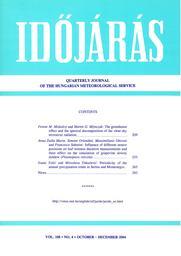Időjárás - Quarterly Journal of the Hungarian Meteorological Service (OMSZ)
Vol. 108, No. 4 * Pages 209–287 * October - December 2004
 |
|
 download [pdf: 120608 KB]
download [pdf: 120608 KB]
The greenhouse effect and the spectral decomposition of the clear-sky terrestrial radiation
Miskolczi Ferenc, Mlynczak, M.G.
idojaras.2004.4.1 (p. 209–)
Miskolczi Ferenc, Mlynczak, M.G.
idojaras.2004.4.1 (p. 209–)
Influence of different sensor positions on leaf wetness duration measurements and their effect on the simulation of grapevine downy mildew (Plasmopara viticola)
Dalla Marta, A., Orlandini, S., Ghironi, M., Sabatini, F.
idojaras.2004.4.2 (p. 253–)
Dalla Marta, A., Orlandini, S., Ghironi, M., Sabatini, F.
idojaras.2004.4.2 (p. 253–)
Periodicity of the annual precipitation totals in Serbia and Montenegro
Tosic, I., Unkasevic; M.
idojaras.2004.4.3 (p. 265–)
Tosic, I., Unkasevic; M.
idojaras.2004.4.3 (p. 265–)
IDŐJÁRÁS - Quarterly Journal

Az IDŐJÁRÁS a HungaroMet Nonprofit Zrt. negyedévenként megjelenő angol nyelvű folyóirata
Megrendelhető a journal.idojaras@met.hu címen.
A szerzőknek szánt útmutató itt olvasható.
Megrendelhető a journal.idojaras@met.hu címen.
A szerzőknek szánt útmutató itt olvasható.









